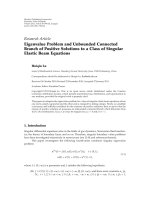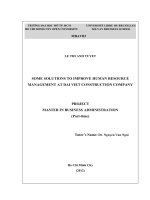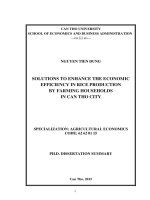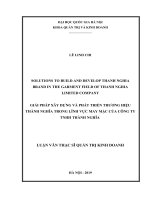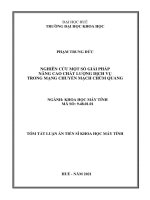Solutions To Improve Efficiency Of Import Operation Of Thanh Loi Company Limited.docx
Bạn đang xem bản rút gọn của tài liệu. Xem và tải ngay bản đầy đủ của tài liệu tại đây (367.11 KB, 42 trang )
NATIONAL ECONOMICS UNIVERSITY
FACULTY OF FOREIGN LANGUAGES
ENGLISH FOR BUSINESS DEPARTMENT
--- o0o ---
NGUYEN PHUONG THANH
SOLUTIONS TO IMPROVE EFFICIENCY OF IMPORT
OPERATION OF THANH LOI COMPANY LIMITED
HANOI, MAY 2011
NATIONAL ECONOMICS UNIVERSITY
FACULTY OF FOREIGN LANGUAGES
ENGLISH FOR BUSINESS DEPARTMENT
--- o0o ---
NGUYEN PHUONG THANH
SOLUTIONS TO IMPROVE EFFICIENCY OF IMPORT
OPERATION OF THANH LOI COMPANY LIMITED
Supervisor: Pham Thi Quynh Hoa, M.A
HANOI, MAY 2011
Nguyễn Phương Thanh- CQ493898- Business English 49B
ACKNOWLEDGEMENT
This report would not have been possible without the guidance and the help
of several individuals who in one way or another contributed and extended their
valuable assistance in the preparation and completion of this report.
First and foremost, I am heartily thankful to my supervisor, Pham Thi Quynh
Hoa, for the continuous support of my research, for her patience, motivation,
enthusiasm, and immense knowledge. Her guidance helped me in all the time of
research and writing of this report.
I wish to express my warm and sincere thanks to all lecturers of Business
English Department for their encouragement and insightful comments.
I would like to show my gratitude to Mrs. Tran Thi Thuy Nga - Managing
Director of Thanh Loi Co. Ldt and Mr. Pham Dinh Khanh - Sale Manager who gave
me opportunity to work in the Import-Export Division and gave me untiring help
during my difficult moments. My thanks also go to Thanh Loi staff for their great
support.
Last but not the least, I owe my deepest gratefulness to my family and my
friends who always encourage and inspire me. All of my progress belong to them.
Nguyễn Phương Thanh- CQ493898- Business English 49B
TABLE OF CONTENTS
EXECUTIVE SUMMARY
INTRODUCTION
CHAPTER 1: INTRODUCTION OF THANH LOI CO.LTD AND ITS
IMPORT BUSINESS..............................................................................................1
1.1 Introduction of Thanh Loi Co.,LTD...............................................................1
1.1.1 The establishment and development.........................................................1
1.1.2 The organizational structure....................................................................2
1.2 Introduction of Thanh Loi’s import business.................................................3
1.2.1 Thanh Loi is an agency of Icom Inc..........................................................3
1.2.2 Business area............................................................................................4
1.2.3 Typical foreign suppliers and customers of the company.........................4
CHAPTER 2: THEORETICAL FRAMEWORK................................................6
2.1 Import basic theory.........................................................................................6
2.1.1 Definition of import..................................................................................6
2.1.2 Features of import....................................................................................6
2.1.3 Roles of import..........................................................................................7
2.1.4 Types of import.........................................................................................7
2.1.4.1 Commission import..........................................................................7
2.1.4.2 Temporary import for re-export.......................................................8
2.1.4.3 Direct import....................................................................................8
2.1.5 Import procedures....................................................................................9
2.1.6 The Incoterms (International Commercial Terms).................................10
2.2 Factors affect businesses’ import efficiency................................................12
2.2.1 External factors.......................................................................................13
2.2.1.1 Political environment........................................................................13
2.2.1.2 Exchange rate...................................................................................13
2.2.1.3 Tariff.................................................................................................13
2.2.1.4 Transportation and communication system.......................................13
2.2.2 Internal factors.......................................................................................14
2.2.2.1 Human Resource...............................................................................14
Nguyễn Phương Thanh- CQ493898- Business English 49B
2.2.2.2 Capital..............................................................................................14
2.2.2.3 Organizational structure...................................................................14
2.3 Import business efficiency and criteria of evaluation.................................15
2.3.1 Import business efficiency.......................................................................15
2.3.2 Criteria of evaluation..............................................................................15
CHAPTER 3: ANALYSIS AND FINDINGS......................................................17
3.1 Analysis of performance outcome................................................................17
3.1.1 General view...........................................................................................17
3.1.2 Revenue..................................................................................................18
3.1.3 Profit ratio..............................................................................................18
3.1.4 Return on equity (ROE) and Return on assets (ROA).............................19
3.1.5 Total Turnover (TAT).............................................................................20
3.1.6 Value of Icom’s import equipment..........................................................21
3.2 Analysis of factors affect Thanh Loi’s import efficiency............................21
3.2.1 Political environment..............................................................................21
3.2.2 Exchange rate.........................................................................................22
3.2.3 Human Resource.....................................................................................22
3.2.4 Capital....................................................................................................22
3.3 Drawback.......................................................................................................23
3.4 Causes of the drawback................................................................................24
CHAPTER 4: RECOMMENDATIONS TO IMPROVE IMPORT OPERATION
EFFICIENCY OF THANH LOI CO., LTD.............................................................25
4.1 Recommendations for the company.............................................................25
4.1.1 Improving efficiency of raising and utilizing capital..............................25
4.1.2 Perfecting import operation....................................................................26
4.1.3 Establishing a marketing department and boosting marketing activities26
4.1.4 Training import-export executives..........................................................27
4.1.5 Practicing employee motivation..............................................................28
4.2 Solutions for the government.......................................................................28
CONCLUSION
REFERENCES
Nguyễn Phương Thanh- CQ493898- Business English 49B
LIST OF TABLE AND CHARTS
Table 1: Profit ratio of Thanh Loi Co. Ldt in 2007-2009........................................19
Table 2: Return on Equity (ROE) and Return on Assets (ROA).............................20
Table 3: Total Assets Turnover...............................................................................21
Table 4: Value of Icom’s imported equipments in 2007 – 2009..............................22
Chart 1: Thanh Loi Co., Ltd organizational structure................................................2
Chart 2: Import procedures........................................................................................9
Chart 3: The value of trade in 2007 – 2009.............................................................18
Chart 4: Evolution of exchange rate between Vietnam Dong and USD..................22
from 2007 to 2009.....................................................................................22
Nguyễn Phương Thanh- CQ493898- Business English 49B
i
EXECUTIVE SUMMARY
Thanh Loi Company Limited is a veteran company in the field of high
technology electronics, telecommunication and information technology. With over
15 years experience, the company had a reputation of providing customers with
high quality equipments and good services. However, during global economic
crisis, the company faced many difficulties such as the decrease of revenue, low rate
of return from equity and return from assets. That’s the reason why the author chose
“Solutions to improve efficiency of import operation of Thanh Loi Company
Limited” as the subject of this report.
The purpose of this report is to give a detail analysis of factors affect import
operation efficiency and import performance outcome of the company in 3 years
from 2007 to 2009. Through the analysis, the author will draw out the achievements
as well as weaknesses in import operation of the company. Based on result of the
analysis, the author suggests some solutions to enhance efficiency of import
business of Thanh Loi.
Apart from the introduction and conclusion, the report is divided into four
chapters. Chapter one is an introduction of Thanh Loi Co. Ltd which includes the
establishment and development, the organization, business area and factors that
affect the company’s import efficiency. The second chapter is theoretical
background, which mentions basic theory about import (definition, features, roles
and types of import), criteria to evaluate import efficiency. Chapter three deals with
analysis of Thanh Loi’s import efficiency. The last chapter presents some solutions
to improve import efficiency of the company.
Nguyễn Phương Thanh- CQ493898- Business English 49B
i
i
INTRODUCTION
1. Introduction of the research topic and rationales
In the age of global economic integration, Vietnam economy was more closely
interwined with the global economy than it had ever been. Among foreign trade
operations, import operation is of paramount important. It supplies raw materials, as
well as consumables which can’t be produced by domestic manufactures.
Founded in 1993, Thanh Loi Company Limited focuses on developing
approaches and solutions in the field of high technology electronics,
telecommunications and information technology. One of its activities is importing
radio communication equipment, monitoring equipment and data analysis for the
various purposes of national defense and security, etc. After 17 years of operation,
Thanh Loi Co.ltd gained many achievements but it faced so many difficulties as
well. That’s why the author choses “Solutions to improve efficiency of import
operation of Thanh Loi Company Limited” as the subject of my report.
2. Purpose and scope of the research
This report mainly aims at:
Analyzing import operation efficiency of Thanh Loi Co. Ltd from
2007 to 2009
Analyzing factors affect import operation of the company
Suggesting some solutions to improve import efficiency of the
company
This report studies import operation of the company in the row of 3 years from
2007 to 2009.
3. Research questions
How does the import business operate during period of 2007-2009?
What are the causes of drawback?
What are the best solutions to improve Thanh Loi’s import efficiency?
4. Sources and methods of the research
Nguyễn Phương Thanh- CQ493898- Business English 49B
i
i
i
Data for this report came from books about International Trade, Import-export
business, current articles, journals online resources and documments of the
company such as financial reports, quotation,etc.
The study is primary based on analysis of figures which reflect the company’s
import efficiency. Through results of the analysis, the author point out achievements
and shortcomings in import operation of the company. From that, some critical
solotions are recommended to enhance the import operation efficiency of Thanh Loi
Co. Ltd.
Nguyễn Phương Thanh- CQ493898- Business English 49B
1
CHAPTER 1: INTRODUCTION OF THANH LOI CO.LTD
AND ITS IMPORT BUSINESS
1.1 Introduction of Thanh Loi Co.,LTD
1.1.1 The establishment and development
Trading name: Thanh Loi Company Limited
Head office: C5/25 Lang Ha Street, Ba Dinh District, Hanoi
Tel: +84 4 3856 2387
Fax: +84 4 3856 1356
Founded in 1993, Thanh Loi Company Limited focuses on developing
approaches and solutions in the field of high technology electronics,
telecommunications and information technology.
With over 15 years experience, it not only provides customers with a single
device but also consults and implements the overall integrated solution or
technology transfer.
Thanh Loi Co.ltd is a trading company that specializes in providing total
engineering solutions, system design consultancy, equipment supply, after sale
services and technical services in the areas enclosed information technology.
At the early stage, the company had the start-up capital of 210 million VND
and the labour force of only 5 people. Up to present, the capital of the company
reached 20 billion VND and the total workforce is 23 people. 90% of Thanh Loi
employees have graduated university with the majors of Economic, Technology,
and International Trading.
In June 2006, the company established its branch in Ho Chi Minh City.
Address: 27/6C Hau Giang, Tan Binh, Ho Chi Minh City
Nguyễn Phương Thanh- CQ493898- Business English 49B
2
1.1.2 The organizational structure
As a small-scale enterprise, Thanh Loi’s management structure includes a
director, a deputy director of finance and administration and a deputy director of
technique. The director is the head of the company and is responsible for controlling
all company’s activities. The two vice-directors assist the director in running the
company. They are responsible to the director for the functioning of their
department.
Chart 1: Thanh Loi Co., Ltd organizational structure
The Director is legally responsible for the whole company as well as manages
every activities of the company. In particular, the director’s missions are:
Laying down the objectives and broad policies of the company
Preparing strategic plans and policies for the company
Controlling and cooperating the activities of all the department
The Deputy Director of Finance and Administration is in charge of all
financial and fiscal management aspects of company operations. Key duties of
Deputy Director of Finance includes staff management, cash and risk management,
accounting and financial controls and budgeting.
Accounting Department: Tracks the assets, liabilities, revenue and expenses
of the company. It provides not only current operating information for
management but also track the historical transactions of the entity. It also
shows which products or assets of the company are most profitable and those
which are weak.
Administration Division: Records and manages number of staff, deals with
paper works, purchases and allocates stationery.
Import-export Division: sets up import plan, implements import procedures.
The Deputy Director of Technique is in charge of the issues related to
technology. He controls the following divisions:
Nguyễn Phương Thanh- CQ493898- Business English 49B
3
Telecommunication Division: In charge of selling equipments and providing
after sale services.
Research and Development Division: Conducts promoting activities.
Ho Chi Minh City Branch: Operates under the control of the director.
1.2 Introduction of Thanh Loi’s import business
1.2.1 Thanh Loi is an agency of Icom Inc.
Icom Inc. is a company located in Osaka, Japan, and is a manufacturer of
wireless communication products. Since Icom’s establishment in 1954, it has had a
long record as a trusted manufacturer of land mobile radio, amateur radio, marine
radio, navigation products, aviation radio and communication receivers.
Icom products are sold in over 80 countries in the world. Icom has an
international sales and service network around the world, including sales
subsidiaries in the US, Australia, Germany, China and Vietnam.
Thanh Loi has been one of the agencies of Icom Inc. since its foundation in
1993. Value of Icom’s products makes up a large proportion of the total import
value of Thanh Loi. In order to enhance business operation, Icom provide Thanh
Loi with technician training courses. Besides, Thanh Loi conducts promotion
activities using the logo and trademark of Icom.
1.2.2 Business area
According to the business license, the company operates in two fields: (1)
Trading electronics and telecommunication devices; (2) providing technical service.
Specifically:
Providing solutions, systems of radio communication equipment for civil and
professional (in-band H / V / UHF, Microwave ,etc.)
Monitoring equipment and data analysis for the various purposes for national
defense and security.
Recording systems, digital video recording for professional use.
Nguyễn Phương Thanh- CQ493898- Business English 49B
4
Systems, equipment and global positioning GPS DGPS for navigation in the
air, at sea, cartography
The navigation equipment used for scalar and Air Force aviation
The equipment used for various satellite stations
Equipment and electronic warfare support electronic warfare (radio
monitoring, navigation, positioning, insert jamming ,...)
The measurement equipment Radio: R & S, Agilent, Tektronics
The solution of the network and security controls to ensure the safety of
neighboring networks
1.2.3 Typical foreign suppliers and customers of the company
a.
Typical foreign suppliers
Thanh Loi serves as agent of, and has strong business relationship with, many
manufactures and companies around the world, including: ICOM Inc. (Japan), ETI
(Denmark), SAAB GROUP, SAAB Systems Grintek, Grintek Ewation (Pty) Ltd.,
DataVoice, Reutech Defense Industries (PTY) Ltd. in South Africa.
b. Typical customers
Military organizations: Communication High Command, Navy High
Command, Air Force – Air Defense High Command, Armored – Tank High
Command, Border Guard High Command
Police Organizations: Professional Technical Department No. 1 and 2,
General Department No. 4
Airline organizations: Northern Aviation Group, Civilian Airline
Control Center, Noi Bai Commercial Enterprise, Southern Airline Service
Company
Other state owned and private enterprises
Above is a complete introduction of Thanh Loi Co., Ltd. It includes information
about the foundation, the organizational structure, business area, suppliers and
customers of the company.
Nguyễn Phương Thanh- CQ493898- Business English 49B
5
CHAPTER 2: THEORETICAL FRAMEWORK
2.1 Import basic theory
2.1.1 Definition of import
The term “import” is derived from the conceptual meaning as to bring in the
goods and services into the port of a country. The buyer of such goods and services is
referred to an “importer” who is based in the country of import whereas the overseas
based seller is referred to as an “exporter”. (Joshi, Rakesh Mohan, (2009) International
Business, Oxford University Press, New Delhi and New York, pp. 178).
Nguyễn Phương Thanh- CQ493898- Business English 49B
6
“Imports” consist of transactions in goods and services (sales, barter, gifts or
grants) from non-residents to residents. (Lequiller, F; Blades, D. Understanding
National Account, Paris: OECD 2006, pp.139-143) The exact definition of imports
in national accounts includes and excludes specific “borderline” cases. A general
delimitation of imports in national accounts is given below:
An import of good occurs when there is a change of ownership from a nonresident to a resident; this does not necessarily imply that the goods in question
physically crosses the frontier. However, in specific cases national accounts impute
changes of ownership even though in legal terms no change of ownership takes
place (e.g. cross border financial leasing, cross border deliveries between affiliates
of the same enterprise, goods crossing the border for significant processing to order
or repair). Also smuggled goods must be included in the import measurement.
Imports of services consist of all services rendered by non-resident to resident.
In national accounts any direct purchases by residents outside the economic territory
of a country are recorded as imports of services; therefore all expenditure by tourists
in the economic territory of another country are considered as part of the imports of
services. Also international flows of illegal services must be included.
2.1.2 Features of import
Import is a complex process, it has the following features:
Import operation is controlled by many kinds of law such as
International agreement on foreign trade, International trade customs,
and national law.
Trading methods on international market are diversified: ordinary
transaction, mediated transaction or transaction at fairs.
Currency used in transaction: strong currencies (USD, Euro)
2.1.3 Roles of import
Import is one of the two elements of foreign trade. It can be taken as the
purchase of goods and services from abroad to meet domestic needs or to reproduce
for profit. Import reflects mutual interdependence between one country’s economy
Nguyễn Phương Thanh- CQ493898- Business English 49B
7
and the world economy. Since nations prefer dialogue than confrontation, the
national economy integrate with the world economy, roles of import become
extremely important.
Import augments national consumption level, allows bigger consumption
Import diversifies product in terms of class, specifications to meet the
people’s need.
Import pushes up technique transportation which helps save time and
money, as well as leads to development of national production.
Import creates competition between domestic goods and foreign goods
which forces domestic producers to make innovation.
Import supplies consumers with special goods (scarce or high technology
product).
2.1.4 Types of import
There are three types of import: commission import, temporary import for reexport and direct import.
2.1.4.1 Commission import
Commission import occurs when a domestic company wants to import goods
but not entitled to do that by its own. That company, hence, must entrust an other
company to complete the import procedures. After the consignee finishes import
procedure it will receive remuneration called “entrust fee”.
In this mode of import, entrusted company must not do market research or pay
any financial contribution. The consignee must draw up two contracts. One to buy
goods from foreign manufactures, another is the written agreement between the
consigner and the consignee.
2.1.4.2 Temporary import for re-export
Temporary import for re-export means a company import goods not for
domestic consumption but for export to the third country for profit. The
imported goods are not treated or processed in the re-export country. Therefore,
Nguyễn Phương Thanh- CQ493898- Business English 49B
8
there are three countries participate in this import procedure: the import country,
the re-export country and the export country.
2.1.4.3 Direct import
A company applies direct import mode when it directly perform every
steps of import procedure (finding partners, negotiating, writing contracts,
completing customs procedures). This type of import may contain more risks but
it also provides greater benefit than other types.
In a direct-import program, the retailer bypasses the local supplier
(colloquial middle-man) and buys the final product directly from the
manufacture, possibly saving in added costs. This type of business is follows the
trends of the global economy.
2.1.5 Import procedures
Nguyễn Phương Thanh- CQ493898- Business English 49B
9
Chart 2: Import procedures
(Source: Airlinklebanon.com/Internaional Trade)
Import procedures include 11 steps as follow:
Step 1: Seller and Buyer conclude a sales contract, with method of payment
usually by letter of credit (documentary credit).
Step 2: Buyer applies to his issuing bank, usually in buyer’s country, for letter
of credit in favor of Seller (beneficiary).
Step 3: Issuing bank requests another bank, usually a correspondent bank in
Seller’s country, to advise, and usually, to confirm, the credit.
Step 4: Advising bank, usually in Seller’s country, forwards letter of credit to
Seller informing about the terms and conditions of credit.
Step 5: If credit terms and conditions conform to sales contract, Seller
prepares goods and documentation, and arranges delivery of goods to carrier.
Step 6: Seller presents documents evidencing the shipment and draft (bill of
exchange) to paying, accepting or negotiating bank name in the credit (the advising
bank usually), or any bank willing to negotiate under the terms of credit.
Nguyễn Phương Thanh- CQ493898- Business English 49B
1
0
Step 7: Bank examines the documents and draft for compliance with credit
terms. If complied with, bank will pay, accept or negotiate.
Step 8: Bank, if other than the issuing bank, sends the documents and draft to
the issuing bank.
Step 9: Bank examines the documents and draft for compliance with credit
terms. If complied with, Seller’s draft is honored.
Step 10: Documents release to buyer after payment, or on other terms agreed
between the bank and Buyer.
Step 11: Buyer surrenders bill of lading to carrier (in case of ocean freight) in
exchange for the goods or the delivery order.
2.1.6 The Incoterms (International Commercial Terms)
Incoterms or International Commercial terms are a series of international sales
with terms, published by International Chamber of Commerce and widely used in
international commercial transactions. These are accepted by governments, legal
authorities and practitioners worldwide for the interpretation of most commonly
used terms international trade. This reduces or removes altogether uncertainties
arising from different interpretation of such terms in different countries. Scope of
this is limited to matters relating to rights and obligations of the parties to the
contract of sale with respect to the delivery of good sold. They are used to divide
transaction costs and responsibilities between buyer and seller and reflect state-ofthe-art transportation practices.
The Incoterms were first published in 1936 and have been regularly up dated
following the changes in international trade needs, till their latest version in 2010.
The international trade terms are grouped in four categories: E, F, C and D, each
one indicated by the first letter of the acronym. Bellow is a list of the most common
used Incoterms
EX-WORKS (From factory to warehouse): The term EXW is commonly used
between the manufacturer/ seller and export-trader/ buyer, and is considered to be
the minimum obligation of the seller among all other Incoterms. Under EXW, the

